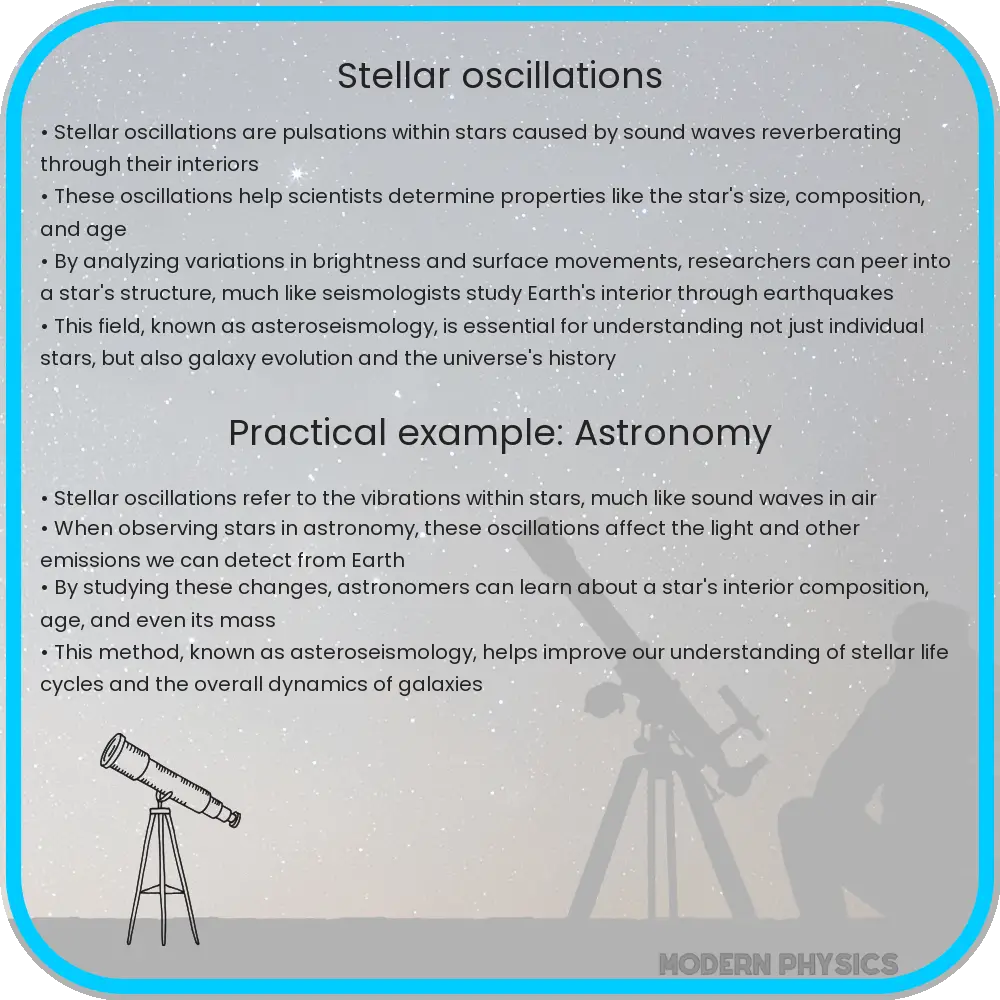Explore the fascinating world of stellar oscillations, key patterns, and their effects on the universe. Understand the theory and advancements in astrophysics.

Understanding Stellar Oscillations
Stellar oscillations, or stellar pulsations, are the rhythmic changes in luminosity and size that many stars undergo. These fluctuations are driven by the internal dynamics of the stars and can provide critical insights into their internal structures and evolutionary states. By studying these oscillations, astronomers can infer a wealth of information about a star’s mass, radius, age, and even chemical composition.
Key Patterns of Stellar Oscillations
One of the most studied patterns in stellar oscillations is the so-called ‘p-mode’ (pressure mode) oscillations. These are sound waves that travel through the star’s interior, driven by pressure changes. They are analogous to the acoustic waves found in musical instruments and can provide a detailed ‘sonogram’ of a star’s interior. Another significant pattern includes ‘g-mode’ (gravity mode) oscillations, which are primarily influenced by the buoyancy forces inside the star and can reveal deeper layers than p-mode oscillations.
Effects of Stellar Oscillations
Stellar oscillations can significantly impact the evolutionary path and stability of a star. For instance, large-amplitude oscillations can lead to mass loss, especially in the late stages of a star’s life. Moreover, the analysis of these oscillations, through a process called asteroseismology, allows scientists to measure the star’s internal rotation, which plays a crucial role in stellar evolution and nucleosynthesis processes.
Theory Behind Stellar Oscillations
The theoretical underpinnings of stellar oscillations are rooted in fluid dynamics and thermodynamics. Stars can be thought of as gigantic spherical masses of ionized gases (plasma), subject to complex forces and reactions. The theory posits that when certain layers within a star become unstable, they can oscillate, causing the star to expand and contract periodically. Mathematical models, including the famous Kappa mechanism, help explain how energy is trapped and released, driving these pulsations. The Kappa mechanism, for example, involves partial ionization zones of elements like helium, where increased opacity leads to trapped energy and consequent expansion.
Advanced Techniques in Studying Stellar Oscillations
Advancements in technology and methodology have significantly enhanced our ability to study stellar oscillations. Space-based telescopes like Kepler and TESS have revolutionized the field by providing high-precision photometric data over extended periods, allowing for the detection of minute oscillations in distant stars. Additionally, ground-based spectroscopy has improved, enabling the measurement of Doppler shifts caused by stellar surface movements, further contributing to our understanding of internal stellar dynamics.
Impact of Stellar Oscillations on Astrophysics
The study of stellar oscillations extends beyond individual stars, impacting broader astrophysical concepts. For instance, by comparing oscillation patterns across different types of stars, astronomers can better understand stellar lifecycles and the mechanisms driving stellar formation and death. Moreover, stellar oscillations have implications for the study of exoplanets, as variations in a star’s light caused by oscillations can affect the detection and analysis of orbiting planets.
Challenges and Future Directions
Despite significant advancements, the study of stellar oscillations faces challenges. One major issue is the complexity of interpreting oscillation data, requiring sophisticated models and computational techniques. Additionally, there are still many stars whose oscillations are too subtle to detect with current technology, limiting our understanding of the full spectrum of stellar behavior. Future research aims to improve the sensitivity and precision of detection methods and to refine the theoretical models that describe stellar internal dynamics.
Conclusion
Stellar oscillations offer a unique window into the inner workings of stars, bridging observational astronomy with theoretical astrophysics. Through the patterns of these oscillations, we can unravel the life stories of stars, from their fiery births to their tranquil or explosive demises. The field continues to evolve, with new technologies and theoretical insights pushing the boundaries of what we know. As we refine our understanding and expand our capabilities, the stars themselves become the ultimate laboratories, revealing the secrets of the cosmos one pulsation at a time.
